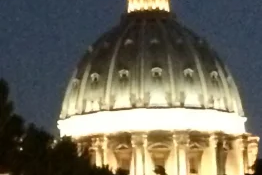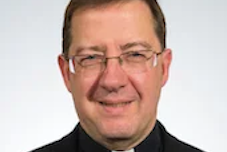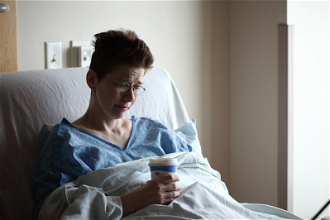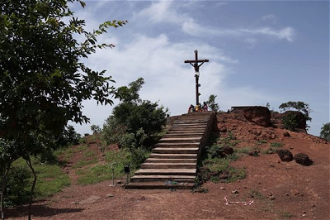Westminster: Silver Jubilee Pilgrimage to Lourdes

Cardinal Emmanuel with Redcaps
Last weekend, more than 1,200 Westminster pilgrims returned from a place "where the veil between heaven and earth is a little thinner, a little lighter.." Cardinal Vincent Nichols led this year's Silver Jubilee Pilgrimage to Lourdes, together with Cardinal Emeritus Cormac Murphy O'Connor and Bishop John Sherrington. More than 400 volunteers, including the Redcaps, led by Paul Lavery, guided the crowds, handed out water, and especially attended to wheelchair-bound pilgrims. Music throughout the week was led by Giovanni Marseglia and Liz Simpson.
On the first day, Cardinal Vincent gave the catechesis, reflecting on the Joy of Conversion. He began by describing the 'three stories of Lourdes' - the story of Bernadette; the story of living and sharing together of the pilgrimage; and the story which may take place in the inner, spiritual life.
"First we are invited by God. God's message comes to us through Mary. The invitation is for us to make a new start in our lives, to turn again to God, our loving Father, with all our hearts.... Let's not be too busy or too full of ourselves to hear this call."
After the invitation comes the conversation. Cardinal Vincent said. "Bernadette was asked to come to the Grotto for two weeks to meet Mary, the Mother of Jesus, and to talk with her. We only have six days. We must go there too, not out of curiosity but to listen and talk honestly.
"We are awaited by God at the Grotto. He is hoping for our presence since He is the one who invited us... This is a conversation in love. It can be long and deep and can contain lots of silence.
"In this conversation, we see our sinfuless, our poverty and problems in a different light. We stop blaming God, putting God in the dock. We come to realise that our sins pull us away from God, who wants to give us the very fulness of life. He needs our whole hearted cooperation to do this.
"Bernadette also teaches us about penance, actions of mind and body which create solidarity between us and all the afflicted of the world. Sin creates wrong habits in us, like creases in a fine dress. Ironing them out takes time and effort.'
Cardinal Vincent then turned his attention to the path from the Grotto: "Mary sent Bernadette to the spring. The Grotto spring and its water are a sign. Our pathway from the Grotto is always to the Church, to the sacraments of the Church, which are for us the spring of true life.
"Going constantly to this spring is the fruit of our conversion, our turning again to God. Our pilgrimage leads us afresh to this spring of sacramental life because our pilgrimage is a pathway to conversion."
Reflecting on two of Our Lady's names, Cardinal Vincent said: "Mary is called 'the Ark of the Covenant' because she carried within her the Eternal Word of God. She brings that Word to us. She brings us to that Word. We too are to be little arks of the covenant, bringing the Word of God within us to others.
"Mary is 'the Immaculate Conception'. This is God's plan for all of us. As St Paul says, "We are to be holy and spotless in his presence". God is doing this work of holiness within us. My that work progress well on our pilgrimage!"
Pilgrims attended Mass at Lourdes parish church where St Bernadette was baptised; there was a Family Mass at the Cathedral of the Trees; an International Mass in the Underground Basilica; healing and penitential services; the Torchlit and Blessed Sacrament processions. Half way through the week, on a very warm evening, Westminster pilgrims attended Mass at the Grotto.
As Cardinal Vincent explained in his homily, because it was supper time in the hotels, Westminster pilgrims had the Grotto all to themselves. He lit a candle for their intentions. At the end of the Mass Liz Simpson and Canon Pat Browne gave a beautiful performance of one of Cardinal Hume's favourite hymns: Andrew Lloyd Webber's Pie Jesu.
Cardinal Vincent then made special mention of Sr Joan Ryan from Harrow, who celebrates her golden anniversary this year, and thanked Catherine Hickman for her tremendous contribution to the pilgrimage over the past 25 years, announcing that she is to be awarded the Bene Merenti Papal medal.
One pilgrim said: " Lourdes is such a special place. I come here each year and although its quite an intensive schedule I always leave feeling spiritually rested, renewed and recalibrated."
The full text of Cardinal Vincent's homily at the Grotto follows:
It is always a great privilege to celebrate Holy Mass here at the Grotto. Here we can sense ourselves to be that little bit closer to heaven. It is as if here the veil between Heaven and earth is a little thinner, a little lighter, and that we can just catch a glimpse of our true home.
It is an even greater privilege to he celebrating Mass here at 7pm, precisely when every hotel in Lourdes is serving dinner. We have this place to ourselves, in some special peace and quiet.
This is our time, then, to bring all our prayers to Mary, to remember before her all those who have asked for our prayers, who are close to our hearts and who are most in need. This is the time to have that conversation with her, the heart to heart to which we have been invited: to listen, to allow silence its proper place in our hearts.
This evening, in a special way, we give thanks for all the blessings received during these 25 years of our Diocesan Pilgrimage to Lourdes. So many people of our diocesan family have made this journey to this holy place, bringing their stories and their prayers. Think of them for a moment: your family members and friends, so many young people, so many religious sisters and brothers, so many teachers, deacons and priests and, of course, today we think especially of Cardinal Hume. He had such a great love for Lourdes and he was such an outstanding teacher of our faith, something which shone with a particular brightness here in Lourdes. He knew the story of St Bernadette so well and he unfolded it for us with such care and insight.
We can think, too, of all the people who have come here for over 150 years, since the first miraculous cure which took place on 1st March 1858. The sick, those broken in body and in spirit have come, countless hands reaching out to take this water, as Mary instructed Bernadette to do; reaching out to touch this rock on which has stood Our Blessed Lady, Mary; the Immaculate Conception and our promise of heaven; Mary the Ark of the Covenant; Mary the Mother of Jesus; Mary, our mother too.
We thank God that we are here! How glad we are! How profoundly we rejoice for, as Isaiah said, 'To us his servants the Lord has revealed his hand.'
We are here to greet Mary and it is so lovely to hear another's greeting in our Gospel passage. We listened to the greeting offered by Elizabeth as Mary comes to visit her:
'Of all women you are the most blessed!'
'Blessed is the fruit of your womb.'
'Blessed is she who believed the promises made her by the Lord would be fulfilled!'
Mary is three times blessed, three times praised, extolled, magnified!
I learned recently that this English word, 'blessed', used to translate the Latin word 'benedicere', comes from a very old English word with links back to a blessing made with blood. Maybe that is not so strange because the blessings granted to Mary carry with them a cost, a great cost. Even as Mary is blessed as the one chosen to bring Jesus into the world, to be the Mother of God, so too she learns that the sword of sorrow will pierce her heart. She will stand at the foot of the cross watching this most precious Son died before her eyes.
This is the nature of blessings. With them comes a mission, a task, and one that demands our all. If we accept the blessing with a full and open heart, then we will also accept the suffering that goes with it. Being chosen by God means at the same time a crown of joy and a crown of thorns.
Receiving the gift of life itself, the very first blessing, means sorrow and joy intertwined. Being given a particular vocation means living with happiness and distress, joy and sorrow. Every mother, every father knows that their vocation is a mingling of sorrow and joy as they nurture and cherish their love and the new life is so often brings.
Sorrow and joy are indeed inseparable. And their intertwining teach us a great lesson, a lesson fundamental to how we approach life and our faith. The lesson is this: Jesus did not come to make life easy; he came to call us to greatness, to make us great! At every time of life, at each stage, whether as youngsters or in old age, this is his invitation: that we strive for greatness, for largeness of heart, for holiness of spirit!
As we gather here on our pilgrimage, we learn this lesson. Jesus calls us to greatness. This is the lesson that Mary offers to us, for she herself, we know, is both Mother of Sorrows and Queen of Heavenly Joy. In her we have a companion in our distress and a promise of joy to come. She is our guide to greatness!
Every one of you carries this lesson with you, on your person, at this moment. It is expressed in the badge of our pilgrimage, on your jacket, on your identity card. Look at it: the ring of thorns, with sharp spines, surrounding the word Pax, Peace. This is a proclamation that peace is a gift of God, God' blessing, and it comes set in a crown of thorns. 'Peace among thorns.' This is our motto, the motto of Cardinal Hume, used a the symbol of this pilgrimage since its beginning.
No peace comes without the thorns of life. We cannot remove or avoid them. If that becomes our chief aim, then we enter a false world, a
self-constructed world that loses touch with the truth of reality and leaves us dissatisfied. And we can only bear the thorns, carry the sorrow, within the promise of peace, the faithful, reliable promise of God to us all.
Blessed is she, Mary, who stood in this place, who stood at the foot of the cross, who is Queen of Heavenly Joy.
Here, in this Grotto, Mary promised happiness to Bernadette, not in this world, but in the next. She gives us the exact same promise. Here we struggle among the thorns of this world. Yet here we find peace and know that it will indeed be fulfilled.
Blessed are you all who believe that the promise made to you by the Lord will be fulfilled.
Amen





















